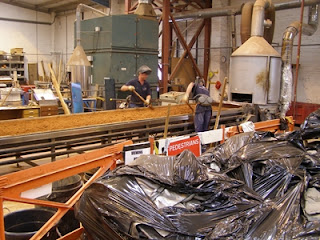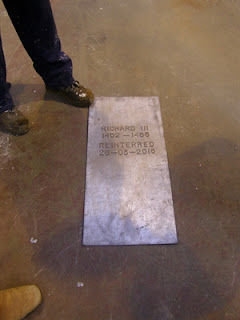 who are doing a lot of stone repairs/replacements on the
church (thanks to our HLF grant).
who are doing a lot of stone repairs/replacements on the
church (thanks to our HLF grant).Apart from seeing the stonemasons at work on our stone, and having a go ourselves (see right - with one of our finished stones in front), we also saw lead sheet being cast (even though they are not doing our roof as it's not lead). This casting is done largely in the traditional manner on sand and N&U say that they are the only people in the country who still do it in this way; they can re-cast the lead from a particular roof and so send back essentially the same material as was removed from the roof, which pleases the heritage-minded.
The casting process is called a "throw", although that seems an odd word for such a carefully done process. It requires a sand bed to be prepared, about 6m x 1.4m, which has to be done from scratch for each casting, obviously with great skill to get it perfectly smooth and level. This photo shows them aerating the bed first. There is a wheel on a track on either side of the bed which helps as they run various wooden tools along it as part of the smoothing process, which is then followed by a final go by hand with upturned copper trays about a foot square.
The furnace at one end is lifted up and tilted to produce a river of molten lead (right) which goes into a trough and then they wait for the temperature to come down slightly to the desired figure (330 deg C, we saw).
Then it is released and flows along the sand (too fast for me to take a picture!), and the two workers take the wooden tool sitting on the wheels along the bed at the right speed, with a bow wave in front (photo left), any surplus lead going off the end into an old bucket on wheels. Done!
Edit: I was also given a DVD by the company, which I watched last night (it was a bad night on TV). I learned that the said wooden item is called a strickler, and to my surprise the verb "strickle" is in my dictionary. It means (in general terms) exactly what the two men were doing with it!
 The thickness of the sheet is controlled only
by the speed at which the workers move along the molten lead. Here the lead has just been poured and they are about to do this critical run along the bed.
The thickness of the sheet is controlled only
by the speed at which the workers move along the molten lead. Here the lead has just been poured and they are about to do this critical run along the bed.Then they cut off the edges and ends, and cut the product into separate sheets and roll it by hand, with all the still warm surplus going back into the furnace for the next go. This produces about 5m of sheet about 1.25m wide, and each go takes about 25 minutes so they can do 16 casts in a day. We saw the sheet cut into four bits, each weighing about 50kg (it was Code 6, I think).
I wouldn't want that job as it looks really physically tiring and I bet they have back problems. There is no doubting their skill at producing such a product but I have no idea how much it costs!
NB N&U did the lead casting for the inscription on the coffin of Richard III. We saw a copy of this which I think is destined for a museum,
and they did an imprint in the sand from the original for us!




